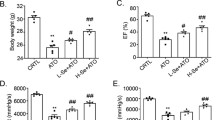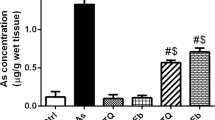Abstract
Aloin exerts concentration-dependent pro-oxidant and antioxidant effects when tested in vitro. Such duality of effects has not been investigated through in vivo studies on aloin. We evaluated the effects of aloin at doses ranging between 1 and 125 mg/kg against the arsenic trioxide (As2O3)–induced cardiotoxicity in mice. As2O3 (5 mg/kg/day) was intraperitoneally administrated for 10 days. Aloin was administered through oral gavage at 1, 5, 25, and 125 mg/kg/day. As2O3 induced rise in ST height and QT interval in ECG, increased oxidative stress, and depleted the antioxidative defense. As2O3 increased inflammatory cytokine concentrations in the heart. Aloin dose dependently inhibited the As2O3-induced cardiotoxicity. There was no evidence of increased oxidative stress in the low-dose aloin-treated mice receiving As2O3. Our results indicate that aloin possesses cardioprotective potentials and its pro-oxidant effect is not evident in vivo at tested doses.





Similar content being viewed by others
References
Ahangarpour A, Zeidooni L, Rezaei M, Alboghobeish S, Samimi A, Oroojan AA (2017) Protective effect of metformin on toxicity of butyric acid and arsenic in isolated liver mitochondria and Langerhans islets in male mice: an in vitro study. Iran J Basic Med Sci 20:1297
Alamolhodaei NS, Shirani K, Karimi G (2015) Arsenic cardiotoxicity: an overview. Environ Toxicol Pharmacol 40:1005–1014
Bhattacharjee S, Pal S (2014) Antilipidemic and cardioprotective effects of vitamin B 12 and folic acid against arsenic toxicity. Int J Pharm Chem Biol Sci 4
Cui Y, Ye Q, Wang H, Li Y, Xia X, Yao W, Qian H (2014) Aloin protects against chronic alcoholic liver injury via attenuating lipid accumulation, oxidative stress and inflammation in mice. Arch Pharm Res 37:1624–1633
Dhawan D, Balasubramanian S, Amonkar AJ, Singh N (1999) Chemopreventive effect of 4′-demethyl epipodophyllotoxin on DMBA/TPA-induced mouse skin carcinogenesis. Carcinogenesis 20:997–1003
Floyd RA (1999) Methods in molecular biology. In: Armstrong D (ed) Free radical and antioxidant protocols, vol 108. Humana Press, Totowa 455 pp
Groom Q, Reynolds T (1987) Barbaloin in Aloe species. Planta Med 53:345–348
Hamiza O, Rehman M, Khan R, Tahir M, Khan A, Lateef A, Sultana S (2014) Chemopreventive effects of aloin against 1, 2-dimethylhydrazine-induced preneoplastic lesions in the colon of Wistar rats. Hum Exp Toxicol 33:148–163
Hemmati A, Olapour S, Varzi HN, Khodayar M, Dianat M, Mohammadian B, Yaghooti H (2018) Ellagic acid protects against arsenic trioxide–induced cardiotoxicity in rat. Hum Exp Toxicol 37:412–419
Jamieson N, Sirdaarta J, Cock I (2014) The anti-proliferative properties of Australian plants with high antioxidant capacities against cancer cell lines. Pharmacogn Commun:4
Kemp GJ (2004) Mitochondrial dysfunction in chronic ischemia and peripheral vascular disease. Mitochondrion 4:629–640
Kono Y, Fridovich I (1982) Superoxide radical inhibits catalase. J Biol Chem 257:5751–5754
Moron MS, Depierre JW, Mannervik B (1979) Levels of glutathione, glutathione reductase and glutathione S-transferase activities in rat lung and liver. Biochim Biophys Acta (BBA) Gen Subj 582:67–78
Ohkawa H, Ohishi N, Yagi K (1978) Reaction of linoleic acid hydroperoxide with thiobarbituric acid. J Lipid Res 19:1053–1057
Pulido MD, Parrish AR (2003) Metal-induced apoptosis: mechanisms. Mutat Res Fundam Mol Mech Mutagen 533:227–241
Radha MH, Laxmipriya NP (2015) Evaluation of biological properties and clinical effectiveness of Aloe vera: a systematic review. J Tradit Complement Med 5:21–26
Sonawane VK et al (2018) A chemosensitizer drug: disulfiram prevents doxorubicin-induced cardiac dysfunction and oxidative stress in rats. Cardiovasc Toxicol 18:459–470
Tian B, Hua Y (2005) Concentration-dependence of prooxidant and antioxidant effects of aloin and aloe-emodin on DNA. Food Chem 91:413–418
Varghese MV, Abhilash M, Alex M, Paul MS, Prathapan A, Raghu K, Nair RH (2017) Attenuation of arsenic trioxide induced cardiotoxicity through flaxseed oil in experimental rats. Redox Rep 22:346–352
Wamer WG, Vath P, Falvey DE (2003) In vitro studies on the photobiological properties of aloe emodin and aloin A. Free Radic Biol Med 34:233–242
Wang M et al (2013) Salvianolic acid B prevents arsenic trioxide-induced cardiotoxicity in vivo and enhances its anticancer activity in vitro. Evid Based Complement Alternat Med:2013
Zhang W, Guo C, Gao R, Ge M, Zhu Y, Zhang Z (2013) The protective role of resveratrol against arsenic trioxide-induced cardiotoxicity. Evid Based Complement Alternat Med:2013
Author information
Authors and Affiliations
Contributions
L. A. B., N. A. B., U. B. M. and C. R. P. carried out the literature search and conducted the animal studies, analyzed the results, and wrote the first draft of the manuscript. S. N. G. and S. O. helped in designing the study. D. D. P. carried out the analytical studies. S. B. and K. R. P. contributed to the design of the study and overall supervision. All authors read and approved the final manuscript.
Corresponding author
Ethics declarations
The study animals were maintained according to the guidelines of the Committee for the Purpose of Control and Supervision of the Experiments on Animals (CPCSEA) established under the Prevention of the Cruelty to Animals Act, 1960, Ministry of Environment and Forests, Government of India. The institutional animal ethics committee reviewed and sanctioned the experimental protocol (protocol approval no. IAEC/CPCSEA/RCPIPER/2018/19-03). The tests performed in this study complied with the protocols of the International Association for the Study of Pain.
Conflict of interest
The authors declare that there is no conflict of interest.
Additional information
Publisher’s note
Springer Nature remains neutral with regard to jurisdictional claims in published maps and institutional affiliations.
Rights and permissions
About this article
Cite this article
Birari, L.A., Mahajan, U.B., Patil, K.R. et al. Aloin protects against arsenic trioxide–induced myocardial membrane damage and release of inflammatory cytokines. Naunyn-Schmiedeberg's Arch Pharmacol 393, 1365–1372 (2020). https://doi.org/10.1007/s00210-020-01833-1
Received:
Accepted:
Published:
Issue Date:
DOI: https://doi.org/10.1007/s00210-020-01833-1




